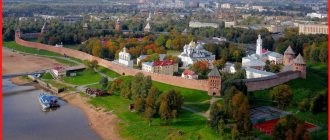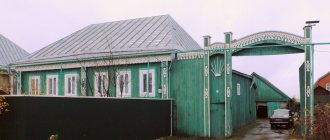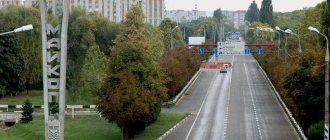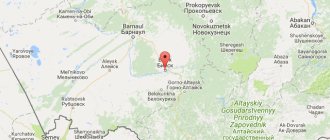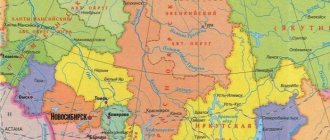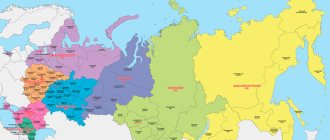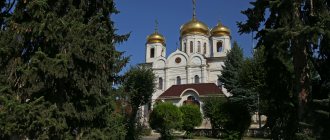From Verkhneudinsk to the capital of Buryatia
The name of the administrative center, unusual for the Russian language, evokes associations with Central Asia or Mongolia. But that's not true. Ulan-Ude , preparing to celebrate its 350th anniversary, became the center of Buryatia in the new Russian history - in the mid-30s of the twentieth century, the city of Vehneudinsk was renamed to Red Noon - this is how today’s name of the capital of the Buryat Republic is translated.
And the story began almost three and a half centuries ago and is connected with the Cossack winter hut, which was built to collect yasak from the local Tungus population. The Buryats and Mongols did not pay taxes. A couple of decades later, a royal decree ordered the construction of the Udinsky fort on this site, marking the beginning of suburban life. In the first third of the eighteenth century, the fort was renamed the city of Verkhneudinsk. The territory begins to be built up as an urban area and becomes part of the Irkutsk governorship.
The next century was marked by the further development of the urban settlement, the construction of stone houses, a guest courtyard, the appearance of industrial and craft enterprises, and a railway station.
By the beginning of the twentieth century, about three dozen educational institutions were operating in the city, the first cars and telephone communications appeared. By the decision of the revolutionary authorities, the city becomes the capital of the newly created Far Eastern Republic, then the Baikal Governorate, and, finally, the Buryat-Mongolian Autonomous Soviet Socialist Republic. In the post-Soviet period, Ulan-Ude received the status of the administrative center of the Republic of Buryatia.
Buryat cooking
Having found out where the city is located, it is also important to find out how things are going with delicious food. The Buryat capital has both restaurants of national cuisine and establishments in the spirit of the good old Europe. Of course, most visitors want to learn as much as possible about local culinary traditions. Since ancient times, the basis of Buryat cuisine has been meat, milk and flour. In traditional restaurants you can order the following dishes:
- Buhler is a rich soup made from meat on bones.
- Shulep – beef broth soup with vegetables and noodles.
- Buuzas or poses - manti with a hole.
- Shangi are flatbreads made from dough that Buryats eat instead of bread.
- Salamat is a porridge made from flour and sour cream.
Buryats drink green tea, although not with sugar and lemon, but with butter, milk and salt. Chinese cuisine is also respected in Buryatia, because Ulan-Ude is not so far from the Middle Kingdom. Here you can taste delicious Chinese dim sum dumplings, which are no different from those served in Beijing.
Buhler is a rich soup made from meat on bones.
Since Mongolia is located next to Buryatia, the dishes of this country can also be tasted here. In Mongolian restaurants in Ulan-Ude you can order: the dish of the Mongolian nomads khorkhog, dried meat borts, tsusan khiam (i.e. blood sausage from sheep), sharsan elig from the liver, shol stew, doortur - a stomach filled with meat and vegetables.
Many tourists, tired of excursions and places imposed by guides, choose to explore the city freely. The best way to explore the city is by walking around it and visiting randomly selected cafes and restaurants. This approach to getting to know Ulan-Ude will allow you to see the true face of the city and taste dishes in those catering places where the Buryats themselves eat.
Climate and ecology of Ulan-Ude
If you like hot summers and bitter cold in winter, you will love the sharply continental climate of the capital city. There have been cases in history when in January the thermometer dropped to 54 degrees. The absolute summer maximum is 40 degrees. The sun shines almost 260 days a year, but the rainy days can be counted on one hand and there is 265 millimeters of precipitation per year. Mainly in July and August. Air humidity does not exceed 65 percent.
Despite the fact that the climate in the city is arid, it was plagued by numerous floods in the 19th century, until a large shaft was built to separate the Uda River from the urban settlement.
Earthquakes have also occurred; the capital is located in a seismically active zone due to its proximity to Lake Baikal (130 kilometers). Over the past decade, up to 150 tremors of small amplitude have been observed. They did not cause casualties or destruction.
The capital of Buryatia boasts clean air in the surrounding area; there are a large number of parks and green areas that can effectively combat the negative impact on the environment; there is a lot of motor transport in the city, and there are traffic jams on the central streets. And yet, the air is so transparent and clean that you can see mountain outlines tens of kilometers away from the city. Citizens are not afraid to drink water from the tap.
Climate
The climate of Buryatia is influenced by many factors. The republic is remote from the oceans and located in the center of the Eurasian continent; moreover, Buryatia is surrounded by mountains. Therefore, the weather here is unique and peculiar, and it is characterized by frequent and sharp variability. The territory of the republic is characterized by a sharply continental climate. There are very cold winters and hot (albeit short-lived) summers. Buryatia is a very sunny republic. In terms of the number of clear days, it can be compared with the Caucasus, Crimea or Central Asia.
Population of Ulan-Ude
According to the rating of 1,100 Russian cities, the capital of Buryatia ranks 42nd in terms of population, 453 thousand people. Experts predict that it may become a big city in the foreseeable future. For this purpose, a municipal demographic program has been adopted, aimed at creating comfortable living conditions for the indigenous population and attracting labor resources from the countryside of the republic and other regions of Russia.
Representatives of 60 nationalities live here. Among them:
- Russians;
- Buryats;
- Mongols;
- Bashkirs;
- Evenks;
- Tajiks;
- Uzbeks;
- Belarusians;
- Ukrainians;
- Lithuanians;
Ulan-Ude is one of the few Russian cities where the male and female population is at parity. The female population predominates by a few percentage points. In recent years, more boys have been born. The population below working age is more than 20 percent. 62 percent of the capital’s residents are of working age (more than 180 thousand citizens), among them the number of people with professional education is growing. These indicators are considered the best among the regions of Siberia.
The average cost of living for the population is 8.5 thousand rubles. For pensioners, the minimum basket is set at 6.6 thousand rubles. The average salary in the economy reaches 32 thousand rubles, according to 2014 data.
The unemployment rate in 2015 is within 1.42 percent, but in the second half of the year a massive reduction is expected in budgetary organizations and in the civil service. About 2,500 people were recognized as unemployed, according to data at the beginning of 2015. There are enough vacancies in the labor market for more than three and a half thousand. The most popular specialties in the labor market are:
- car mechanic;
- mechanic;
- electrician;
- carpenter;
- tire production master;
- driver;
- mason;
- designer;
- marketer;
- administrator;
- a kindergarten teacher;
- real estate market specialist;
- insurance agent.
In 2014, the city created 4,500 new jobs in the following segments:
- wholesale and retail trade;
- services sector;
- tourism and hotel business;
- construction;
- cargo transportation.
Minerals
Buryatia is the richest territory of our country in terms of mineral reserves. More than 700 deposits have been explored here. Gold, tungsten, uranium, molybdenum, beryllium, tin, aluminum are only a small part of all minerals. And the reserves of hard and brown coal will be enough for the needs of the republic for hundreds of years. It should be noted that the subsoil of this region contains about 48 percent of Russia's balance zinc reserves. The capital of Buryatia is the center of industrial enterprises for the processing of natural resources.
Budget and investments
The capital's budget revenues in 2015 will amount to 3.6 billion rubles. The third part of the expenses is aimed at developing education and preparing for the celebration of the 350th anniversary of the city. The budget deficit is planned to be kept within 10 percent of revenues of 300 million rubles. Interestingly, the city fathers plan to achieve a budget surplus by 2016. Primarily due to investment projects, both public and private. Since 2014, more than fifty promising projects have been implemented in the republic with a total capital investment of up to 250 billion rubles. The largest of them:
- construction of regional roads with a length of 40 kilometers;
- reconstruction of 200 kilometers of federal highways;
- reconstruction of 17 bridges with the construction of 9 entrances;
- construction of three autotourist complexes;
- construction of infrastructure for a tourist and recreational park with a complex of buildings in Podlemorye;
- fortification and hydraulic structures on the banks of the Selenga River;
- landscaping of urban areas and new buildings in the steppe zone;
- construction of production facilities for processing solid waste;
- expansion of the capital's airport runway;
- complex development of microdistricts of the capital in the southern direction.
Such large investments are aimed at improving the demographic situation in the region and increasing the living comfort of citizens. In the long term, it is calculated that the number of capital residents will double by 2027.
Districts and new buildings
There has been a noticeable acceleration in housing construction. If in 2006 less than one hundred thousand square meters were commissioned in the region, then in 2014 there were 207 thousand square meters or 2,400 apartments. For 2015, the government of the republic has set an ambitious goal of putting into operation at least 3,500 comfortable apartments. Massive construction is carried out mainly in the capital of the republic, where residents from rural settlements and other Russian regions are moving.
Immigrants are attracted by the number of jobs with decent salaries, the relative cheapness of life in comparison with Irkutsk, Chita and Novosibirsk, and affordable housing. The average price per square meter in the city does not exceed 40 thousand rubles. The average citizen's salary is enough to purchase one square meter of housing per month.
The capital's development policy has changed from spot compacting to high-rise blocks. In 2014, 17 hectares of city land were allocated for complex development for the implementation of the Housing for Russian Family program. As part of the state program, more than one hundred thousand square meters will be built at a price not exceeding 30 thousand rubles.
The city administration is putting up for auction land plots for individual housing construction: eight acres will cost new residents half a million rubles.
In the Oktyabrsky district, the following are attractive to citizens:
- Residential complex Nikolsky, consisting of high-rise residential buildings with underground parking. The complex is located near the center, near shopping centers, schools, kindergartens, and a clinic. At the construction stage, and it will be put into operation in 2016, the cost per square meter is negligible 33 thousand rubles.
- Residential complex Angara 2 offers apartments in five 16-story towers. Within walking distance of a market, school, clinic, university, kindergarten. There is a children's playground on the roof of the underground parking lot. A square meter of housing will cost 42 thousand rubles. All houses have been put into operation.
- Residential complex Favorite is located in the very center. You can get to any area of the city by public transport without transfers. A three-room apartment with an area of over 80 square meters in a brick house costs 3.2 million rubles.
- The Flagman residential complex is surrounded by the sights of the Mother of Buryatia monument, Selingovsky Bridge, Megatitan and Eldorado shopping centers. One-room apartments up to 40 square meters are valued at 1.7 million rubles.
There is no comprehensive residential development underway in the Zheleznodorozhny district of the capital, but in new buildings on Oktyabrskaya Street you will be offered many apartments starting from 45 thousand rubles. A plot of 6 acres for individual housing construction is available for 200 thousand rubles.
In the cottage village of Lesnaya Polyana (Sovetsky district), you can purchase real estate with an area of 150 square meters for only 1 million 150 thousand rubles under hot offers. A house with a rough finish and a plot of 8 acres in the same area will cost a new resident 1.35 million rubles. An apartment near the airport with an area of 33 square meters is being put up for auction for 1.2 million rubles.
Surprisingly, secondary housing in the capital is cheaper than new buildings. You can find an option from 20 thousand per square meter of housing.
Geography
Buryatia is located on the eastern shore of Lake Baikal, in the very heart of Asia. The republic's southern neighbor is Mongolia. From the north, Buryatia borders on the Irkutsk region, Tyva adjoins the western part, and the Trans-Baikal Territory adjoins the eastern part. The area of the republic is about 351 thousand square kilometers. The geography of Buryatia is unique. All zones of Eurasia meet here: taiga, mountains, tundra, steppes, plains, desert. There are a lot of healing springs with mineral water in Buryatia. Local residents call them Ashans and consider them sacred places.
Sights and culture
The main attraction of the capital is a bronze monument to the leader of the world proletariat, an almost eight-meter tall head of Lenin cast in bronze, rising on a high, more than six meters, granite pedestal. Its production took 42 tons of non-ferrous metal.
In the vicinity of the city, the main shrine of Russian Buddhists was erected, the Ivolginsky Datsan Khambyn Sume. Thousands of pilgrims and tourists come here to explore the unique temple complex. Guests can stay at a hotel on the territory of the monastery.
The Rinpoche Bagsha Buddhist Center houses the largest gilded Buddha statue.
The ethnographic museum, whose holdings occupy more than 40 hectares, introduces guests to the history of the peoples of Transbaikalia. Thousands of copies telling about the historical development of Buryatia are collected in one open-air place.
Walking along Lenin Street, the pedestrian part of which was named the Buryat Arbat, you will see the symbolic coat of arms of the republic - a marble sculpture with bronze snakes, the Rod of the god of trade Mercury and a cornucopia.
The sculptural composition Beauty of the Angara is installed near the Opera and Ballet Theater. The dance composition is dedicated to the outstanding ballet masters of Buryatia.
On the central street of Kuibyshev there is the Trinity Church of the late 18th century, the shopping arcade of the merchant Kurbatov. Here you can walk around the estate of the tradesman Burlakov.
The largest museums, theaters, and exhibition halls of the republic are concentrated in the capital. The national song and dance theater Baikal successfully tours around the world.
Guests of the city enjoy visiting numerous museums:
- Museum of the History of Buryatia, where the richest collection of Buddhist religious objects is collected;
- Museum of Nature of the Republic;
- Art Museum;
- Museum of Applied Arts.
Nature of Buryatia
The nature of the republic is diverse and rich: dense forests, high mountains, valleys and rivers. There are a lot of plants and animals listed in the Red Book: brown bear, Barguzin sable, red deer, mountain goat, reindeer and many others (about 40 species).
Travelers will love this amazing region. There's a lot to see here. Next will be a list of 7 natural wonders of Buryatia, a must-see for every self-respecting traveler.
Seventh place – Yukhta area (Zakamensky district). Here you will see an amazing mountain ensemble. This place is located at the confluence of the Dzhida and Yukhta rivers. The rocks resemble a fortress. They acquired such a bizarre shape under the pressure of rain and winds. From the tops of the mountains you can see a beautiful panorama - a valley with steep cliffs. You can admire the views not only from the top of the rocks, but also while crossing the river.
The sixth place is the Alla River gorge (Kurumkansky district). The valley of this river is cut by ancient glaciers. It flows through narrow canyon-like gorges. According to tourists, this is the most beautiful place on the planet. Everyone, without exception, is breathtaking from the incredibly beautiful and majestic panorama and the fast-moving mountain river.
Fifth place is a waterfall in the valley of the Shumilikha River (Severobaikalsky district). It is located 10 kilometers from Lake Baikal. In order to see it, you need to walk along the ecological trail on the southern border of the Barguzinsky Nature Reserve at an altitude of one kilometer above sea level. The waterfall rushes down the bizarre rocks with a powerful roar.
The fourth place is the Garginsky thermal spring (Kurumkansky district). This source has been known since the eighteenth century. It is located in the valley of the Gargi River. The source temperature is from 25 to 75 degrees Celsius. The composition of the water is considered low-mineralized, slightly alkaline with a high content of radon. People with various ailments come here. Water heals diseases of muscles, bones, tendons, gynecological and dermatological diseases.
Third place – Slyudyanskie Lakes (Severobaikalsky district). These lakes are located 25 kilometers from Lake Baikal and are residual lakes of the Bay of Baikal. They got their name because of the mica mined in these places since the seventeenth century. They are surrounded by a pine forest, which creates an unusually beautiful view.
Second place - Mount Under Baabay (Zakamensky district). This mountain is a beautiful mountain range. An unusually picturesque view opens from the top.
The first place is Mount Barkhan-Uula (Kurumkansky district). According to Tibetan legends, Mount Barkhan-Uula is one of the five places where the main spirits live. There is a belief that a person who manages to conquer this mountain will become one with God.
Education
At the beginning of the 19th century, the population of the territory was not literate. There was only one public school, where they learned crafts and school basics. Today, a quarter of the capital's population are students of secondary specialized and higher educational institutions. There are over 80 secondary schools and the same number of kindergartens in the city. By 2016, according to the administration's plans, there will be no queues in preschool institutions in the city. New kindergartens are being built in housing complexes in the south-eastern part of the city.
More than 35 thousand young people study in 17 universities of the republic: 5 state universities and 12 branches. Specialists are trained:
- Buryat State University;
- East Siberian State University of Technology and Management;
- Agricultural Academy;
- Institute of Public Administration
- Agricultural Academy
- Institute of Railway Transport.
Young people receive secondary vocational education in 17 technical schools, colleges and schools.
The city has the Buryat Scientific Center of the Siberian Branch of the Russian Academy of Sciences, industry research institutes, and a fruit and berry experimental agricultural station.
Healthcare
In addition to a developed network of clinics and hospitals, a unique state Center for Oriental Medicine with several buildings has been created in the city. The following services are provided here:
- bioenergetic diagnostics;
- biochemical studies;
- consultations with narrow specialists;
- treatment using Tibetan medicine methods;
- rehabilitation.
There are a number of private medical centers and offices in the capital of the republic. The Center for Oriental Medicine also provides a number of paid services.
